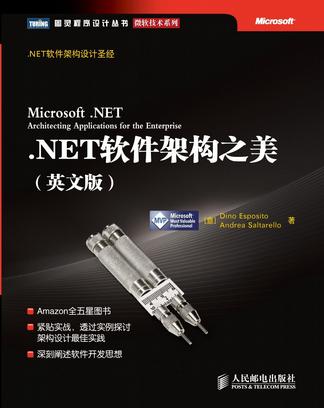《.NET軟體架構之美》是人民郵電出版社出版的一本圖書,作者(義大利)埃斯波西托(Dino Esposito)、 (義大利)索爾塔雷羅(Andrea Saltarello)。
基本介紹
- 書名:.NET軟體架構之美
- 作者:DinoEsposito
- ISBN:9787115200181
- 頁數: 432頁
- 出版社:人民郵電出版社
- 出版時間:2009年9月1日
- 裝幀:平裝
- 開本:16
- 正文語種:英語
- 叢書名 :圖靈程式設計叢書微軟技術系列
作者簡介,內容簡介,媒體評論,目錄,
作者簡介
DinoEsposito,.NET和軟體架構技術方面的世界級權威,微軟ASP.NETMVP。目前就職於著名的.NET技術諮詢公司IDesign。他是廣受歡迎的技術作家。擔任MSDNMagazine特邀專欄作家多年。並撰有ProgrammingASP.NET-3.5CoreReferences等名著。
AndreaSaItareIIo,微軟ASP.NETMVP。義大利.NET用戶組負責人。現任ManagedDesigns公司首席軟體架構師。
內容簡介
《.NET軟體架構之美(英文版)》出自兩位具有多年軟體開發經驗的 ASP .NET專家、作者和培訓師之手,內容涉及多層架構、設計模式以及設計原則。第一部分簡要介紹 UML、設計原則及模式;第二部分從技術架構角度討論分層設計。《.NET軟體架構之美(英文版)》行文流暢,語言通俗易懂,闡述了各種架構設計技術方案的優與劣,並講述了如何在優與劣中做出權衡。中設計了真實的場景,展示了如何將這些設計原則更加具體地套用到 .NET應用程式中。
《.NET軟體架構之美(英文版)》適合各層次 .NET開發人員閱讀。
媒體評論
“所有架構師的必讀之作……無可替代。”
——.NET Developer's Journal
“還等什麼?如果你有機會看到本書,請儘快把它‘消滅’。就像我在捷運上如饑似渴地暢讀一樣……”
——王濤(AnyTao)。微軟MVP
“本書酣暢淋漓地闡發了.NET平台下企業軟體架構的精髓。為開發人員獻上了不可多得的饕餮大餐。”
——陳黎夫(Dflying),微軟MVP
目錄
Part Ⅰ Principles
1 Architects and Architecture Today
What's a Software Architecture, Anyway?
Applying Architectural Principles to Software
What's Architecture and What's Not
Architecture Is About Decisions
Requirements and Quality of Software
Who's the Architect, Anyway?
An Architect's Responsibilities
How Many Types of Architects Do You Know?
Common Misconceptions About Architects
Overview of the Software Development Process
The Software Life Cycle
Models for Software Development
Summary
Murphy's Laws of the Chapter
2 UML Essentials
UML at a Glance
Motivation for and History of Modeling Languages
UML Modes and Usage
UML Diagrams
Use-Case Diagrams
Class Diagrams
Sequence Diagrams
Summary
Murphy's Laws of the Chapter
3 Design Principles and Patterns
Basic Design Principles
For What the Alarm Bell Should Ring
Structured Design
Separation of Concerns
Object-Oriented Design
Basic OOD Principles
Advanced Principles
From Principles to Patterns
What's a Pattern, Anyway?
Patterns vs. Idioms
Dependency Injection
Applying Requirements by Design
Testability
Security
From Objects to Aspects
Aspect-Oriented Programming
AOP in Action
Summary
Murphy's Laws of the Chapter
Part Ⅱ Design of the System
4 The Business Layer
What's the Business Logic Layer, Anyway?
Dissecting the Business Layer
Where Would You Fit the BLL?
Business and Other Layers
Patterns for Creating the Business Layer
The Transaction Script Pattern
Generalities of the TS Pattern
The Pattern in Action
The Table Module Pattern
Generalities of the TM Pattern
The TM Pattern in Action
The Active Record Pattern
Generalities of the AR Pattern
The AR Pattern in Action
The Domain Model Pattern
Generalities of the DM Pattern
The DM Pattern in Action
Summary
Murphy's Laws of the Chapter
5 The Service Layer
What's the Service Layer, Anyway?
Responsibilities of the Service Layer
What's a Service, Anyway?
Services in the Service Layer
The Service Layer Pattern in Action
Generalities of the Service Layer Pattern
The Service Layer Pattern in Action
Related Patterns
The Remote Fa?ade Pattern
The Data Transfer Object Pattern
The Adapter Pattern
DTO vs. Assembly
Service-Oriented Architecture
Tenets of SOA
What SOA Is Not
SOA and the Service Layer
The Very Special Case of Rich Web Front Ends
Refactoring the Service Layer
Designing an AJAX Service Layer
Securing the AJAX Service Layer
Summary
Murphy's Laws of the Chapter
6 The Data Access Layer
What's the Data Access Layer, Anyway?
Functional Requirements of the Data Access Layer
Responsibilities of the Data Access Layer
The Data Access Layer and Other Layers
Designing Your Own Data Access Layer
The Contract of the DAL
The Plugin Pattern
The Inversion of Control Pattern
Laying the Groundwork for a Data Context
Crafting Your Own Data Access Layer
Implementing the Persistence Layer
Implementing Query Services
Implementing Transactional Semantics
Implementing Uniquing and Identity Maps
Implementing Concurrency
Implementing Lazy Loading
Power to the DAL with an O/RM Tool
Object/Relational Mappers
Using an O/RM Tool to Build a DAL
To SP or Not to SP
About Myths and Stored Procedures
What About Dynamic SQL?
Summary
Murphy's Laws of the Chapter
7 The Presentation Layer
User Interface and Presentation Logic
Responsibilities of the Presentation Layer
Responsibilities of the User Interface
Common Pitfalls of a Presentation Layer
Evolution of the Presentation Patterns
The Model-View-Controller Pattern
The Model-View-Presenter Pattern
The Presentation Model Pattern
Choosing a Pattern for the User Interface
Design of the Presentation
What Data Is Displayed in the View?
Processing User Actions
Idiomatic Presentation Design
MVP in Web Presentations
MVP in Windows Presentations
Summary
Murphy's Laws of the Chapter
Final Thoughts
Appendix: The Northwind Starter Kit
Index

